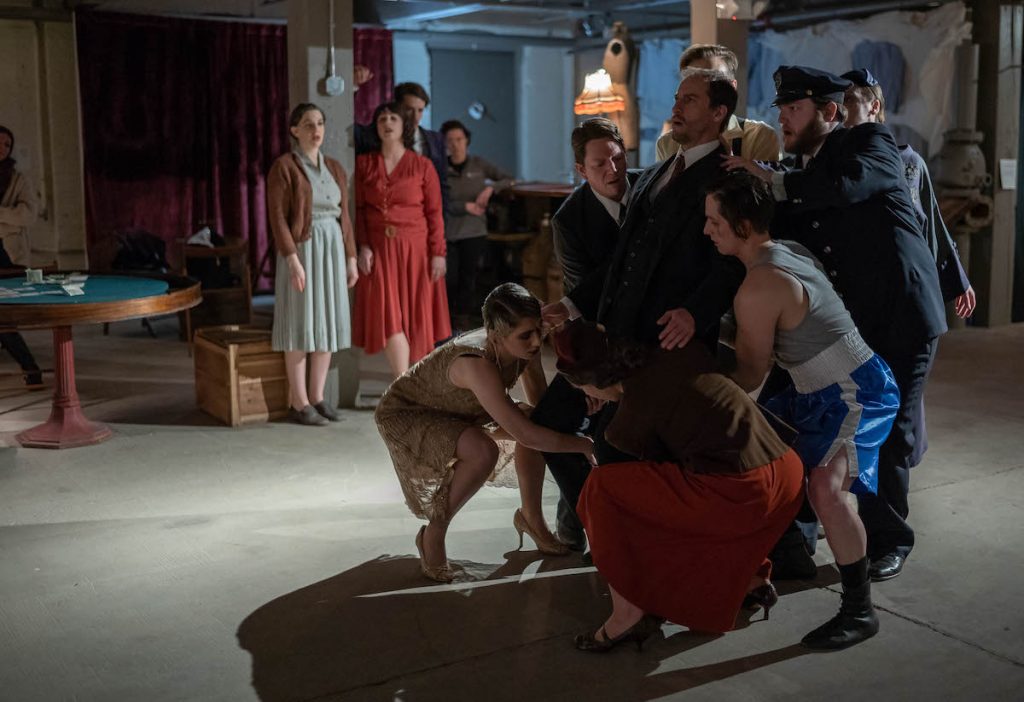In many communities, the word “theater” primarily conjures up images of a darkened room inside a shopping mall where one can catch the latest installment of the “Avengers” series. Not so in the Capital Region, where a wealth of small companies offers an experience much closer to the word’s original concept — an arena for dramatic performance in the tradition of the ancient Greeks.
Literally dozens of small local theater companies have managed to carve out a sustainable existence, which is no small feat in an era where myriad entertainment choices are readily accessible and demand little of their audiences.
Entertainment can be streamed into living rooms and treated essentially as background noise. The theater, of course, is different. Silence and attentiveness are essential; a ringing cell phone can destroy the suspension of disbelief. To see a show, a potential audience member also needs to venture outside the comforts of home, make arrangements and purchase a ticket that can cost more than a long-term subscription to entertainment on demand.
What makes it possible to keep this ancient art form alive, against the odds, in our humble corner of upstate New York? Theaters employ a broad variety of strategies to keep the doors open, and to keep audiences coming. Here’s a look at some of them — plus a few thoughts on what we could be doing better.
Grants and donations
The fact that the state of New York contains the city that is essentially the theater capital of the world is both a blessing and a curse. More energy around the art form in the state makes more money available to spend on it; at the same time, funding is liable to remain concentrated in the small part of the state where the bulk of it is being produced. However, the New York State Council on the Arts (NYSCA) actively works to counteract this by distributing money throughout the state through its Decentralization Program (DEC). Founded in 1977, the DEC has been effective in creating partnerships between the council and local arts agencies that might otherwise be overlooked. The program is administered locally by the Arts Center of the Capital Region for the counties of Albany, Rensselaer and Schenectady; and by Saratoga Arts for Saratoga county.
There are also programs such as the annual Wine & Dine for the Arts, which has successfully created a culinary pairing between arts organizations and Albany chefs; and the fiscal sponsorship offering of the New York Foundation for the Arts (NYFA). The latter allows emerging arts organizations to utilize the foundation’s tax-exempt status, helping them to gain access to funding resources that would otherwise be closed to them — including grants and tax-deductible donations.
Given that the requirements to achieve nonprofit status can be daunting, some theaters take an alternate approach that allows them to aim for profitability while partnering with nonprofits to be eligible for grants.
The strategy has been successful for Albany-based Creative License Theater Collective. Co-artistic director Casey Polomaine refers to it as a “unique challenge” because it requires the company to create new, grantworthy programs to complement its shows. “Any time we’ve gotten a grant it’s always been for something that’s a little bit different, in line with our mission and (that of) the organization that we’ve partnered with,” she said.

One example was the company’s production of “The Picture of Dorian Gray.” Working with the Albany Barn, a nonprofit creative arts incubator and community arts center in Arbor Hill, Creative License not only presented the show but offered free workshops on set construction, costume design and marketing. “It was geared toward people in the community that might have always been interested in theater, but didn’t really know how to start,” Polomaine added. “So, it was like, yes, this grant is supporting a show — but it’s also supporting this other cool thing that will ultimately uplift our theater community.”
Michael Kennedy, artistic director for Creative Action Unlimited, also partners with nonprofit community organizations. “That kind of collaboration is particularly important to me,” she said. “I would be partnering with community agencies whether I was a 501(c)(3) or not, because it’s an important part of our mission.” The company is known for social issues-focused theater and has created traveling pieces that tackle issues including homelessness, addiction and suicide.

Motivation and participation
Several Capital Region companies are fully staffed by motivated theater lovers who lend their time and talents to every aspect of operation, from onstage performance to technical design to marketing to house management. Impressive as this is, the strength of the volunteering spirit can also be a double-edged sword: All those passionate people making theater happen without pay make it less necessary for companies to create paid positions at all. As a result, it can be challenging to make a living as a full-time theater professional in the area.
Still, the plethora of volunteer opportunities makes for a greater number of entry points into a craft often viewed as exclusionary. And not all nonprofessional theater in the region is strictly volunteer; some companies offer stipends or small paychecks to select members of the crew, such as directors, stage managers and pit musicians — or to everyone involved.
Polomaine agrees with this philosophy. “We feel that everyone puts in equal work to put on a show,” she said. “Everyone’s putting in their time and their energy and their attention, so everyone should benefit financially.” Whatever money the company takes in from a show is used first to pay back expenses and save for the next production; what’s left is split among those who worked on the show.
Will Kempe’s Players, a company named for a comic actor who worked alongside Shakespeare, was founded as a worker-owned cooperative — the same financial model used by traveling troupes in the Elizabethan era. “Everything that we make, we divide among the company members,” explained Angelina Castro, the company’s marketing and communications manager. “We have equal shares in the company.”
The region also has begun to attract more notice from Actors’ Equity, the professional union representing theatrical actors and stage managers. The union’s presence is reflected in the recent founding of the Greater Albany Liaison Area, designed to foster greater cooperation with the national headquarters in New York City. Trailblazing new avenues for offering Equity contracts at local theaters is among the list of priorities for the partnership.

“We’re trying to raise awareness of the number of professional actors who make their home in the Capital Region,” said Yvonne Perry, chair of the liaison group. “It’s wonderful that we have such as vibrant community theater atmosphere in this area, but our audiences sometimes don’t understand why their ticket prices are higher at a place where they actually are paying their actors,” she added. “Eventually, we hope to encourage some of the nonprofessional theaters to hire some of our professional actors. Equity is making it easier for them to do so.”
Moreover, pros like Perry who choose to plant one foot firmly in upstate terra firma can manage to make a living doing theater through a willingness to piece together a variety of related gigs. There also are professionals who move upstate to retire, or simply to take a respite from the bustle of the city and soon find themselves involved in smaller-scale theatrical projects in their new digs. All these factors add up to a healthy range of quality in the region’s theaters: It’s not a monochromatic broth; it’s a hearty stew. And there is a discernible trajectory for those who aspire to transition their theatrical interest from hobby to career.
Marketing and publicity
For an art form that literally cannot exist without an audience, getting the word out is crucial. Theaters in the Capital Region have a history of receiving strong support from media outlets, and small theaters have benefited from the media push to increase hyperlocal coverage to stay competitive. The Delta Xi Cast of Alpha Psi Omega, a theater group long associated with the RPI Playhouse, also offers free email services that any company can use to post auditions and announcements.
Social media certainly also plays a role. “That’s where people are tuning to nowadays,” Castro acknowledged. She noted that platforms such as Facebook events calendars are especially important for keeping track of a company like hers, which is constantly traveling. But her commitment to direct interaction is refreshing. “We have to make relationships with the communities that we go into,” she said. “The most important thing is to have face-to-face conversations with people about your show… really talk about the art that you’re doing with everybody that you see.”
Places and spaces
Among the greatest expenses faced by small theater companies are the costs associated with the actual physical space where performances take place. But an emergent trend in the region to minimize these takes the form of a nomadic approach that produces site-specific theater in alternate spaces. In this model, a group sets up temporary shop within an existing building — often one that might otherwise be overlooked or underutilized — and creates a piece of theater uniquely informed by and shaped around the space itself.

While Creative License considers Albany Barn its home base, the company also has ventured out to other Capital Region locales that might be a better fit. “We encounter a lot of plays that would not be suited for the barn at all,” explained Polomaine. “The barn is large and open, expansive, and this (for example) is a two-person ghost story,” she said, referring to the company’s recent production of “The Turn of the Screw” on one of the upper floors at Ten Broeck Mansion.
Room to improve
While it’s clear that the Capital Region theater scene is thriving, an informal survey that we ran for this article revealed some areas where it’s falling short.
One is diversity. Respondents said there are not enough opportunities for people of color, or enough storylines highlighting communities that have been systematically marginalized. The insularity of the community — wherein the same actors keep appearing on the local theater circuit, doing the same shows and performing for audiences largely made up of friends — was also identified as problematic.
Some respondents felt that there were already too many companies in the region, with each struggling to maintain an audience. The need for more technical talent, as well as better marketing, also seem to be felt more keenly than the need for more performers.
A good problem
Still, there was general alignment with the sentiment expressed by one anonymous respondent, who said “The large number of companies creates what I call ‘a good problem to have.’”
Kennedy agrees. “As long as local theater companies are providing high-quality performances, are clear about what makes them unique and are consistent with that vision, new audiences can always be generated,” she said.
Perhaps the most promising bit of constructive criticism revealed by the survey is that Capital Region audiences seem to be looking for more “edgy” work, and they appreciate when companies aren’t afraid to explore the possibilities. “I greatly admire the spirit of experimentation that so many directors and theater groups currently espouse, from site-specificity to reinterpretation to getting away from typecasting,” said Patrick Quinn, a Loudonville resident who dove headfirst into the regional acting scene after retiring from his role as Institute Professor of Architecture at RPI. “Several groups now have a festival of short plays, and some warmly invite submission of new plays by local authors.”
Comments like this clearly indicate that, here in the Capital Region, the spirit of this ancient art form — originally used to explore the world of the Greeks and what it meant to be human — is very much alive.






Nice article, Tony,well organized and nicely positive.
Thank you Patrick!